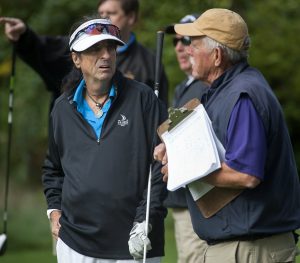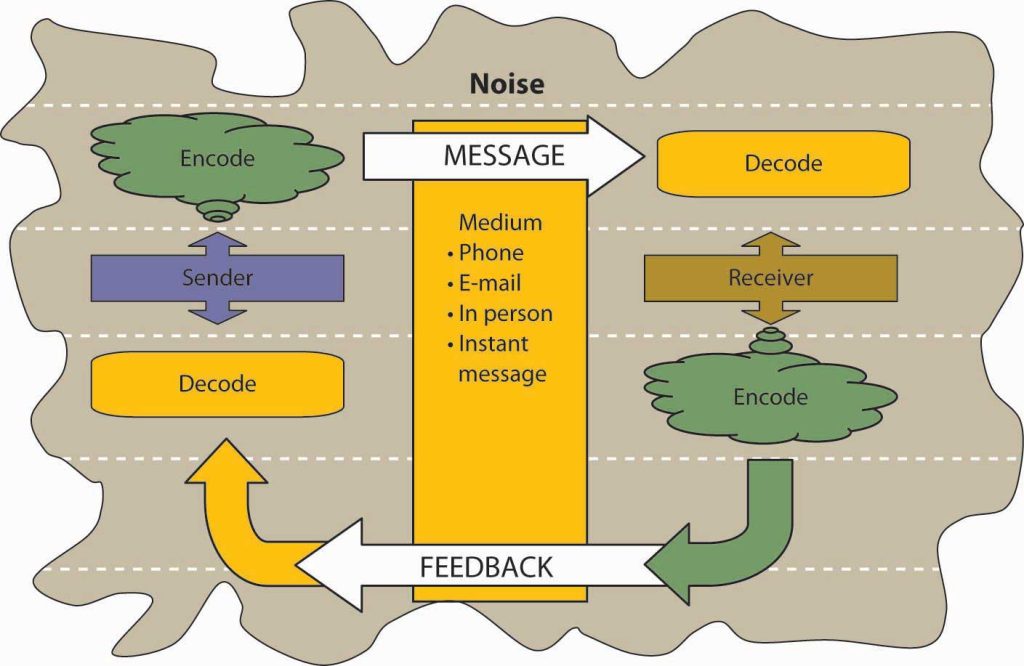8.0 Understanding Communication
Learning Objectives
- Define communication.
- Outline the communication process.
Communication is vital to organizations—it’s how we coordinate actions and achieve goals. It is defined in Webster’s dictionary as a process by which information is exchanged between individuals through a common system of symbols, signs, or behaviour. We know that 50% to 90% of a manager’s time is spent communicating (Schnake et al., 1990), and communication ability is related to a manager’s performance (Penley et al., 1991). In most work environments, a miscommunication is an annoyance—it can interrupt workflow by causing delays and interpersonal strife. But, in some work arenas, like operating rooms and airplane cockpits, communication can be a matter of life and death.

Effective communication is crucial in the golf industry, impacting everything from member satisfaction to business operations. Clear and consistent communication between golf course staff, members and guests ensures a positive experience and fosters strong relationships.
Here’s how communication is key in the golf industry:
1. Building Strong Relationships:
- Open Dialogue: Engaging in open and honest communication, even about difficult topics like course conditions or member complaints, helps build trust and rapport.
- Active Listening: Being a good listener and actively seeking to understand members’ and guests’ concerns is essential for addressing issues and improving service.
2. Maintaining Course Operations:
- Staff Communication: Daily communication between superintendents, golf pros, and other staff members ensures everyone is on the same page regarding course maintenance, player schedules, and course conditions.
- Proactive Communication: Communicating maintenance plans and anticipated changes to members in advance can help manage expectations and minimize disruptions.
- Utilizing Technology: Tools like two-way radios and text messaging can streamline communication and ensure efficient management of course operations.
 3. Engaging with Members and Guests:
3. Engaging with Members and Guests:
- Diverse Communication Channels: Utilizing various channels, including social media, email, and in-person interactions, can effectively reach different segments of the golfing audience.
- Clear and Concise Messaging: Ensuring that all communication is clear, concise, and easy to understand helps members and guests feel informed and valued.
- Proactive Feedback Collection: Gathering feedback from members and guests through surveys, social media, or in-person conversations helps identify areas for improvement and ensure a positive experience.
4. Promoting a Positive Culture:
- Leadership Communication: Strong leadership communication, both internally and externally, sets the tone for the golf course culture and fosters a sense of community.
- Empowering Staff: Empowering staff to communicate effectively with members and guests can create a more welcoming and responsive environment.
- Building Trust: Open and honest communication helps build trust between staff, members, and guests, creating a stronger sense of community.
By prioritizing communication, golf courses can create a more positive and enjoyable experience for everyone involved, leading to increased member satisfaction, stronger relationships, and improved business outcomes.
The Communication Process
Communication fulfills three main functions within an organization, including coordination, transmission of information, and sharing emotions and feelings. All these functions are vital to a successful organization. The coordination of effort within an organization helps people work toward the same goals. Transmitting information is a vital part of this process. Sharing emotions and feelings bonds teams and unites people in times of celebration and crisis. Effective communication helps people grasp issues, build rapport with coworkers, and achieve consensus. So, how can we communicate effectively? The first step is to understand the communication process.
We all exchange information with others countless times each day by phone, text message, e-mail, printed word, and of course, in person. Let us take a moment to see how a typical communication works using this as a guide.

Image Description
A “Sender” encodes a message and sends it through a chosen medium to the “Receiver,” who decodes it. The receiver then encodes feedback and sends it back to the sender, who decodes it. Arrows indicate the direction of communication and feedback flow. The entire process is surrounded by a brown cloud labelled “Noise,” indicating potential interference.
Communication Process Example
A sender, such as a boss, coworker, or customer, originates the message with a thought. For example, the boss’s thought could be: “Get more golf carts from the shed!”
The sender encodes the message, translating the idea into words.
The boss may communicate this thought by saying, “Hey you guys, let’s get more golf carts from the shed.”
The medium of this encoded message may be spoken words, written words, or signs.
The receiver is the person who receives the message.
The receiver decodes the message by assigning meaning to the words.
In this example, our receiver, Bill, has a to-do list a mile long. “The boss must know how much work I already have,” the receiver thinks. Bill’s mind translates his boss’s message as, “Could you get more carts from the shed, in addition to everything else I asked you to do this week…if you can find the time?”
The meaning that the receiver assigns may not be the meaning that the sender intended, because of factors such as noise. Noise is anything that interferes with or distorts the message being transmitted. Noise can be external in the environment (such as distractions) or it can be within the receiver. For example, the receiver may be extremely nervous and unable to pay attention to the message. Noise can even occur within the sender: The sender may be unwilling to take the time to convey an accurate message, or the words that are chosen can be ambiguous and prone to misinterpretation.
Communication Process Example Continued
Picture the next scene. The place: a staff meeting. The time: a few days later. Bill’s boss believes the message about golf carts has been received.
“Are the golf carts here yet?” Bill’s boss asks.
“You never said it was a rush job!” Bill protests.
“But!”
“But!”
Miscommunications like these happen in the workplace every day. We’ve seen that miscommunication does occur in the workplace, but how does a miscommunication happen? It helps to think of the communication process. The series of arrows pointing the way from the sender to the receiver and back again can, and often do, fall short of their target.
Exercises
- Where have you seen the communication process break down at work? At school? At home?
- Explain how miscommunication might be related to an accident at work.
- Give an example of noise during the communication process.
“8.2: Understanding Communication” from Organizational Behavior by LibreTexts is licensed under a Creative Commons Attribution-NonCommercial-ShareAlike 3.0 International License, except where otherwise noted.

